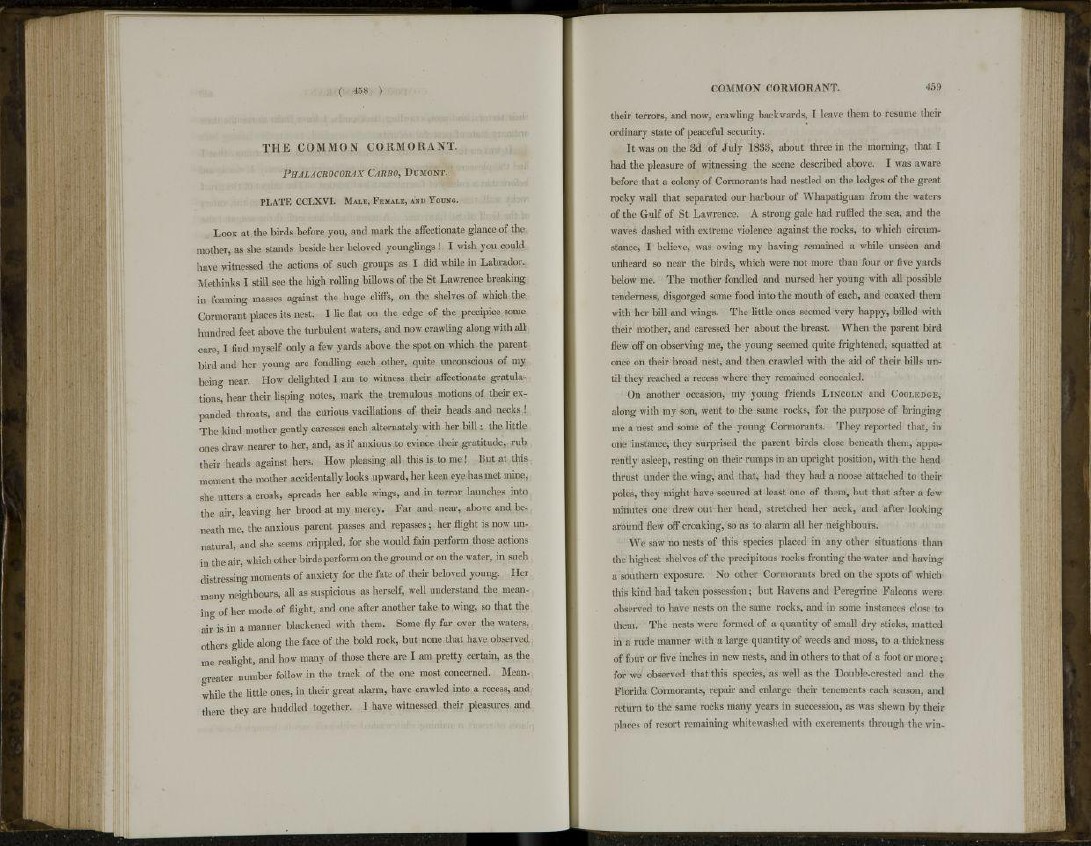
THE COMMON CORMORANT.
P H A L A C R O C O R A X CARBO, DUMONT.
PLATE CCLXVI. MALE, FEMALE, AND YOUNG.
LOOK at the birds before you, and mark the affectionate glance of the
mother, as she stands beside her beloved younglings ! I wish you could
have witnessed the actions of such groups as I did while in Labrador.
Methinks I still see the high rolling billows of the St Lawrence breaking
in foaming masses against the huge cliffs, on the shelves of which the
Cormorant places its nest. I lie flat on the edge of the precipice some
hundred feet above the turbulent waters, and now crawling along with all
care, I find myself only a few yards above the spot on which the parent
bird and her young are fondling each other, quite unconscious of mv
being near. How delighted I am to witness their affectionate gratulations,
hear their lisping notes, mark the tremulous motions of their expanded
throats, and the curious vacillations of their heads and necks !
The kind mother gently caresses each alternately with her bill; the little
ones draw nearer to her, and, as if anxious to evince their gratitude, rub
their heads against hers. How pleasing all this is to me! But at this
moment the mother accidentally looks upward, her keen eye has met mine,
she utters a croak, spreads her sable wings, and in terror launches into
the air, leaving her brood at my mercy. Far and near, above and beneath
me, the anxious parent passes and repasses; her flight is now unnatural,
and she seems crippled, for she would fain perform those actions
in the air, which other birds perform on the ground or on the water, in such
distressing moments of anxiety for the fate of their beloved young. Her
many neighbours, all as suspicious as herself, well understand the meaning
of her mode of flight, and one after another take to wing, so that the
air is in a manner blackened with them. Some fly far over the waters,
others glide along the face of the bold rock, but none that have observed
me realight, and how many of those there are I am pretty certain, as the
greater number follow in the track of the one most concerned. Meanwhile
the little ones, in their great alarm, have crawled into a recess, and
there they are huddled together. I have witnessed their pleasures and
their terrors, and now, crawling backwards, I leave them to resume their
ordinary state of peaceful security.
It was on the 3d of July 1833, about three in the morning, that I
had the pleasure of witnessing the scene described above. I was aware
before that a colony of Cormorants had nestled on the ledges of the great
rocky wall that separated our harbour of Whapatiguan from the waters
of the Gulf of St Lawrence. A strong gale had ruffled the sea, and the
waves dashed with extreme violence against the rocks, to which circumstance,
I believe, was owing my having remained a while unseen and
unheard so near the birds, which were not more than four or five yards
below me. The mother fondled and nursed her young with all possible
tenderness, disgorged some food into the mouth of each, and coaxed them
with her bill and wings. The little ones seemed very happy, billed with
their mother, and caressed her about the breast. When the parent bird
flew off on observing me, the young seemed quite frightened, squatted at
once on their broad nest, and then crawled with the aid of their bills until
they reached a recess where they remained concealed.
On another occasion, my young friends LINCOLN and COOLEDGK,
along with my son, went to the same rocks, for the purpose of bringing
me a nest and some of the young Cormorants. They reported that, in
one instance, they surprised the parent birds close beneath them, apparently
asleep, resting on their rumps in an upright position, with the head
thrust under the wing, and that, had they had a noose attached to their
poles, they might have secured at least one of them, but that after a tew
minutes one drew out her head, stretched her neck, and after looking
around flew off croaking, so as to alarm all her neighbours.
We saw no nests of this species placed in any other situations than
the highest shelves of the precipitous rocks fronting the water and having
a southern exposure. No other Cormorants bred on the spots of which
this kind had taken possession; but Ravens and Peregrine Falcons were
observed to have nests on the same rocks, and in some instances close to
them. The nests were formed of a quantity of small dry sticks, matted
in a rude manner with a large quantity of weeds and moss, to a thickness
of four or five inches in new nests, and in others to that of a foot or more;
for we observed that this species, as well as the Double-crested and the
Florida Cormorants, repair and enlarge their tenements each season, and
return to the same rocks many years in succession, as was shewn by their
places of resort remaining whitewashed with excrements through the win